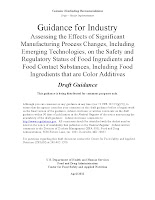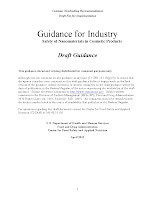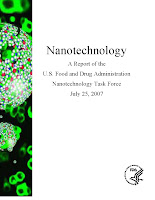Nanotechnology Overview
Nanotechnology is an emerging technology that has the potential to be used in a broad array of FDA-regulated products, including medical products, foods and cosmetics. Nanomaterials, developed using nanotechnology, are measured in nanometers -- equal to about one-billionth of a meter -- so small that they can’t be seen with a regular microscope. These nanomaterials can have different chemical, physical, or biological properties than their conventionally-scaled counterpart materials used in many products regulated by FDA.
FDA has long encountered the combination of promise, risk, and uncertainty that accompanies emerging technologies. Nanotechnology is not unique in this regard. The very changes in biological, chemical and other properties that can make nanotechnology applications so exciting also may merit examination to determine any effects on product safety, effectiveness, or other attributes. Understanding nanotechnology remains a top FDA priority. FDA is monitoring the evolving science and has a robust research agenda to help assess the safety and effectiveness of products using nanotechnology.
Strong science is critical to FDA’s ongoing review of the products it regulates. FDA is investing in an FDA-wide nanotechnology regulatory science program to further enhance FDA’s scientific capabilities, including developing necessary data and tools to identify properties of nanomaterials and assess the impact they may have on products. In general, FDA considers the current framework for safety assessments sufficiently robust and flexible to be appropriate for a variety of materials, including nanomaterials.
FDA is maintaining a product-focused and science-based regulatory policy to appropriately regulate products using this emerging technology. Legal standards vary among various product-classes that FDA regulates. FDA will regulate nanotechnology products under existing statutory authorities, in accordance with the specific legal standards applicable to each type of product under its jurisdiction. The agency is taking a prudent scientific approach to assess each product on its own merits, and does not make broad, general assumptions about the safety of nanotechnology products.
FDA’s Action on Nanotechnology
 In June 2011, FDA issued a draft guidance a Draft Guidance for Industry entitled, "Considering Whether an FDA-Regulated Product Involves the Application of Nanotechnology" to present its thinking on considerations related to nanotechnology.[1] In that draft guidance, FDA indicated that the Agency would issue product-specific guidances in the future, as appropriate.
In June 2011, FDA issued a draft guidance a Draft Guidance for Industry entitled, "Considering Whether an FDA-Regulated Product Involves the Application of Nanotechnology" to present its thinking on considerations related to nanotechnology.[1] In that draft guidance, FDA indicated that the Agency would issue product-specific guidances in the future, as appropriate.Accordingly, FDA is issuing for public comment two product-specific draft guidance documents to address the use of nanotechnology by the foods and cosmetics industries. Both guidance documents are being issued as part of FDA’s ongoing implementation of recommendations from FDA’s 2007 Nanotechnology Task Force Report.
The draft foods guidance alerts manufacturers to the potential impact of any significant manufacturing process change, including those involving nanotechnology, on the safety and regulatory status of food substances. This guidance describes the factors manufacturers should consider when determining whether a significant change in manufacturing process for a food substance already in the market:
- Affects the identity of the food substance;
- Affects the safety of the use of the food substance;
- Affects the regulatory status of the use of the food substance; and
- Warrants a regulatory submission to FDA.
The draft foods guidance also recommends manufacturers consult with FDA regarding a significant change in manufacturing process for a food substance already in the market.
The draft cosmetics guidance, describes FDA’s current thinking on the safety assessment of nanomaterials when used in cosmetic products.
- Cosmetics are not subject to premarket approval; however, they must be safe for consumers under labeled or customary conditions use, and they must be properly labeled.
- Cosmetics manufactured using nanomaterials are subject to the same legal requirements as any other cosmetics. Companies and individuals who market cosmetics are legally responsible for the safety of their products.
- In general, the processes currently in use for assessing safety are appropriate for cosmetics containing nanomaterials. However, data needs and testing methods should be evaluated in light of the properties or functions that may be exhibited by nanomaterials used in cosmetic products
FDA’s Approach to Regulation of Nanotechnology Products
FDA will continue to regulate nanotechnology products under its existing statutory authorities, in accordance with the specific legal standards applicable to each type of product under its jurisdiction. FDA intends to ensure transparent and predictable regulatory pathways grounded in the best available science.
- One size does not fit all. We intend our regulatory approach to be adaptive and flexible. It is necessary for technical assessments to be product-specific, taking into account the effects of nanomaterials in the particular biological and mechanical context of each product and its intended use.
- Particular approaches for each product area will vary according to the statutory authorities. The scope and issues covered in the two draft guidance documents released today – one for foods and one for cosmetics – reflect this approach.
- FDA’s regulatory policy approach is consistent with relevant overarching U.S. government policy principles, and supports innovation under appropriate oversight.
Industry remains responsible for ensuring that its products meet all applicable legal requirements, including standards for safety -- regardless of the emerging nature of a technology involved in the manufacturing a product.
FDA encourages industry to consult early with the agency to address any questions related to the safety, effectiveness, or other attributes of products that contain nanomaterials, or about the regulatory status of such products.
Comments on the Draft Guidance Documents
- Anyone may comment on any guidance at any time. In order to ensure that FDA considers comments on these draft guidance documents in developing the final guidances, electronic or written comments on these draft guidances should be submitted within 90 days of the publication of the notice of availability in theFederal Register. Electronic comments should be submitted to http://www.regulations.gov/. Written comments should be submitted to the Division of Dockets Management, (HFA-305), Food and Drug Administration, 5630 Fishers Lane, Rm. 1061, Rockville, MD 20852.
For More Information
- Nanotechnology Task Force Report 2007 July 2007



